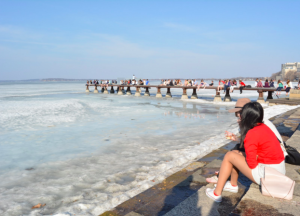Debating how to measure water quality
Posted by millis2 on Tuesday, December 1, 2015 · Leave a Comment
by Cadence Bambenek
The University of Wisconsin-Madison’s Center for Limnology intensively researches area lake water quality with support from the university. The not-for-profit Clean Lakes Alliance supports the Center for Limnology research and in turn works to educate community members about water quality in the Yahara watershed.
“These lakes are said to be the most studied in the world,” Clean Lake Alliance’s Watershed Coordinator Katie Nicholas said.
But while research and resources have been poured into studying and cleaning up Madison’s lakes over the past three decades, studies show that water quality management has only kept pace with new developments in the urban areas surrounding the lakes, just barely countering the pollution.
According to Nicholas, just 16 percent of the phosphorus has been removed from area lakes, but it is their stated goal to remove 50 percent of the phosphorous by 2025.

Jim Lorman, professor at Edgewood College, worries about issues of equity related to the lakes.(Cadence Bambenek)
High amounts of phosphorous runoff from agriculture taints the water with high levels of nutrients, increasing the number and intensity of algae blooms in the area lakes. While green algae is benign, blue-green algae is actually a bacteria and can produce toxins potent enough to kill mammals.
Paul Dearlove, the Watershed Program Manager for Clean Lakes Alliance, emphasized that CLA is addressing the amount of phosphorous in area waters because, according to an engineer they commissioned, phosphorus reduction is the most efficient way to apply a limited number of resources for the biggest return on investment.
While phosphorous is an important component in addressing the quality of water in the Yahara Watershed, Jim Lorman, a professor and Community Partnership Specialist at Edgewood College and former board member of Clean Lakes Alliance, doubts that the emphasis on phosphorus removal reflects the more immediate needs of the greater Madison community.
Dearlove said that CLA is inclusive in its decision making, noting the ‘Lake User Survey’ that CLA executed in 2014. CLA staffed interns and volunteers at over 50 public access points to collect information through questionnaires about how the lakes are being used and by what demographics of people.
Dearlove also believes CLA’s Board of Directors is diverse, as it is actually a Community Board comprised of leadership from local businesses, government, nonprofits, and members of the university, as well as area farmers.
While the Clean Lakes Alliance attempts to engage the greater Madison community by getting community members actually out at the lakes and on, or in, the water through different events, Lorman expressed doubts about the not-for-profit’s priorities.
On the second Thursday of every month, Clean Lakes Alliance hosts an educational talk, Yahara Lakes 101, which is open to the public. The different talks revolve around the science of the lakes. Lorman takes issue with the fact that the organization charges admission to these talks. The Clean Lakes Alliance hosts an annual Frozen Assets Festival and Fundraiser every winter, Lorman called the fundraiser a formal event “for people with privilege and funding.”
“We need to meet people where they’re at,” Lorman said. “Let’s not just invite them to our table, but go to their table.”
Lorman would like to see a more inclusive public participation process, because as he sees it, lake pollution disproportionately impacts low-income families and people of color.
“To me, safe swimming should be a top priority for the city and county,” Lorman said. “Vilas Beach on Lake Wingra is historically the most heavily used in the city.”
Access to safe beaches and safe swimming is a high priority for disenfranchised groups because they don’t have the resources to join a pool club, Lorman said. And a number of the low-income families rely on fish for food and might be unaware of the health hazards.
Lorman believes it begins with communication, with placements of signs in different languages warning about the hazards of swimming or fishing in the local waters.
Lorman noted that, right now, every lake in Wisconsin has a fish advisory to specifically limit the number of fish considered safe for consumption by pregnant women because of the unhealthy amounts of mercury found in the fish.
The Clean Lakes Alliance operates on a $700,000 annual budget supported by Lands’ End, Spectrum Brands, Madison Gas and Electric, ATC, Hy Cite Corp. and the Madison Community Foundation.
Lorman speculated that not all of the donors contribute to the organization for completely altruistic reasons, saying that many actually owns shorefront property. He is concerned that focusing on phosphorous will reduce weeds and algae blooms for a cosmetic end, predominantly to benefit the boaters and water-skiers.
“Marginalized populations in the city probably are less impacted by the algae and weeds because they don’t have boats or own shorefront property,” Lorman said.
Looking at the current hierarchical structure, Lorman said, “We need to be asking ourselves, ‘What would a more inclusive process look like?’”
Category: Madison Problems, Social Justice · Tags: Cadence Bambenek, Environment, Inequality
The arc of the moral universe is long, but it bends toward justice.
-Martin Luther King Jr.
 The Arc: Visions of justice
The Arc: Visions of justice